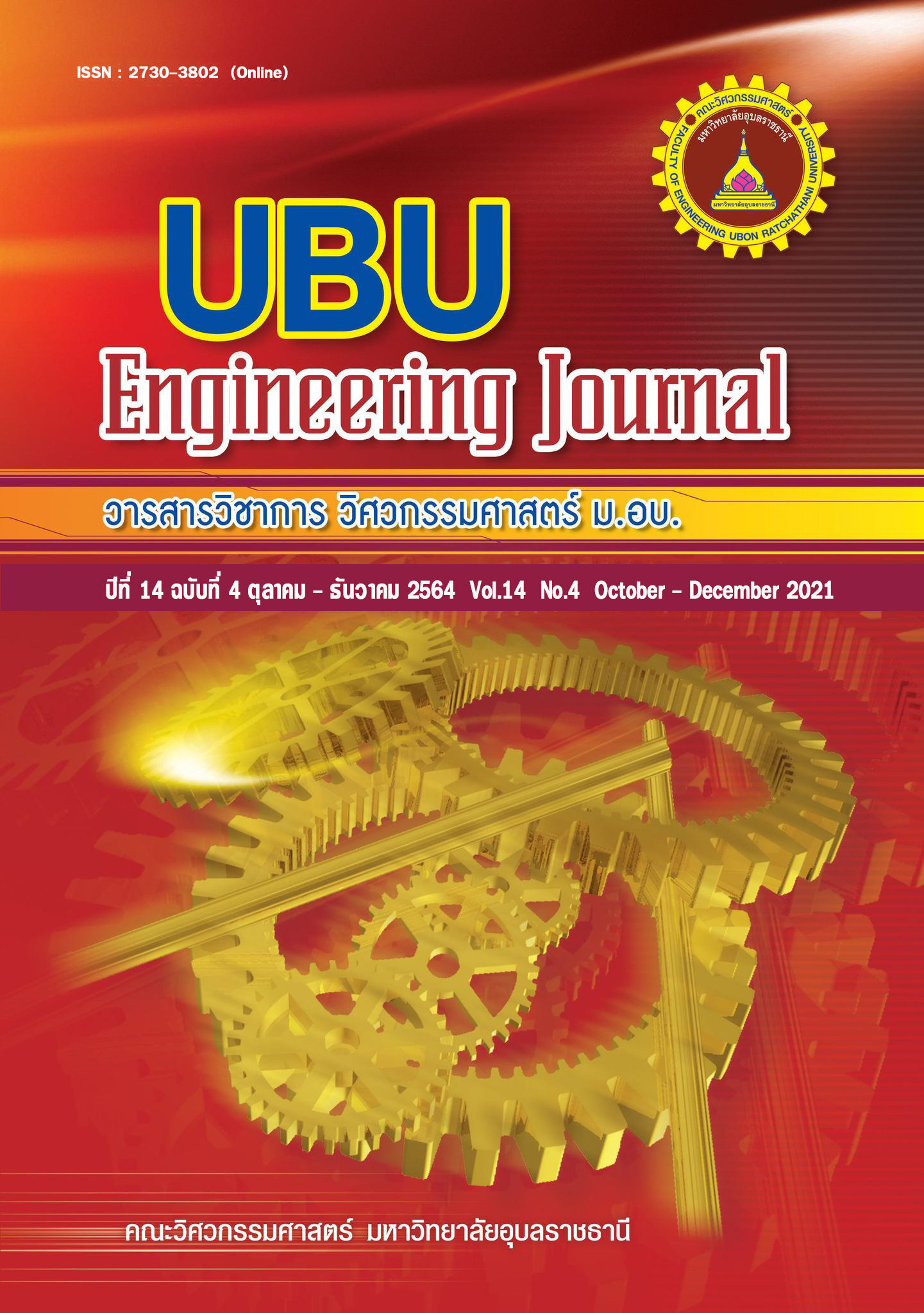Energy Efficiency of Paddy Dehydration Process using Vortex Dryer
Main Article Content
Abstract
Vortex dryer is a novel drying process for drying high-moisture particulate materials such as freshly-harvested paddy or drowned paddy. However, studies of the performance and energy efficiency of the vortex dryer are still incomplete. In this study, a vortex dryer was constructed and study the overall performance in terms of the volumetric water evaporation rate, volumetric heat transfer coefficient, mean particle residence time and specific energy consumption of the dryer was investigated. The drying chamber of the dryer has a diameter of 240 mm, a width of 84 mm, a height of the air inlet of 24 mm and has the chimney outlet diameter of 72 mm. Then, drying the paddy with the initial moisture content of 22% (d.b.) at various drying parameters, namely the drying temperature, the particles feed rate and the constant inlet air velocity of 50 m/s. It was found that the constructed vortex dryer could reduce the moisture content of paddy by 3.63 to 8.87% (d.b.) and the lowest final moisture content of paddy was found to be around 13.20% (d.b.). For the maximum volumetric water evaporation rate was found to be around 475.86 kgwater/m3 h and the maximum volumetric heat transfer coefficient was found to be around 4,190.79 W/m3 ºC. In the case of the mean particle residence time it was found that the mean particle residence time was in the range of 14.07 to 19.17 s. For the total specific energy consumption of the vortex dryer it was found that the lowest total specific energy consumption was to be around 5.6 MJ/kgwater at a drying temperature of 160ºC and a particles feed rate of 70 kgdry solid/h.
Article Details
References
[2] Sangdao C, Songsermpong S, Krairiksh M. A continuous fluidized bed microwave paddy drying system using applicators with perpendicular slots on a concentric cylindrical cavity. Drying Technology. 2011; 29: 35-46.
[3] Soponronnarit S, Yapha M, Prachayawarakorn S. Cross-flow fluidized bed paddy dryer: Prototype and commercialization. Drying Technology. 1995; 13: 2207-2216.
[4] Nguyen LH, Driscoll RH, Srzednicki G. Drying of high moisture content paddy in a pilot scale triangular spouted bed dryer. Drying Technology. 2001; 19(2): 375-387.
[5] สักกมน เทพหัสดิน ณ อยุธยา. การอบแห้งอาหารและวัสดุชีวภาพ. กรุงเทพฯ: สำนักพิมพ์ท้อป; 2555.
[6] Choicharoen K, Devahastin S, Soponronnarit S. Performance and energy consumption of an impinging stream dryer. Drying Technology. 2010; 28: 20-29.
[7] Nimmol C, Sathapornprasath K, Devahastin S. Drying of high-moisture paddy using a combined impinging stream and pneumatic drying system. Drying Technology. 2012; 30: 1854-1862.
[8] Pruengam P, Soponronnarit S, Prachayawarakorn S, Devahastin S. Rapid drying of parboiled paddy using hot air impinging stream dryer. Drying Technology. 2014; 32: 1949-1955.
[9] Pruengam P, Soponronnarit S, Prachayawarakorn S, Devahastin S. Evolution of mechanical properties of parboiled brown rice kernels during impinging stream drying. Drying Technology. 2016; 34: 1843-1853.
[10] Kudra T, Mujumdar AS. Special Drying techniques and novel dryers, In Mujumdar AS. Eds. Handbook of Industrial Drying. 4th ed. Boca Raton: CRC Press; 2014; 433-489.
[11] เสฐียรพงษ์ บุญวัฒน์, ขวัญชัย จ้อยเจริญ. ผลของตัวแปรทางอุทกพลศาสตร์ที่มีต่อเวลาเฉลี่ยที่วัสดุอยู่ในระบบอบแห้งแบบกระแสวน. การประชุมวิชาการระดับชาติ ครั้งที่ 15 มหาวิทยาลัยเกษตรศาสตร์ วิทยาเขตกำแพงแสน, นครปฐม ประเทศไทย 6-7 ธันวาคม 2561. 2561. หน้า 252-262.
[12] Kitron Y, Tamir A. Performance of a coaxial gas-solid two-impinging-streams (TIS) reactor: Hydrodynamics, residence time distribution, and drying heat transfer. Industrial & Engineering Chemistry Research. 1988; 27: 1760-1767.
[13] Nimmol C, Devahastin S. Evaluation of performance and energy consumption of an impinging stream dryer for paddy. Applied Thermal Engineering. 2010; 30: 2204-2212.
[14] Choicharoen K, Devahastin S, Soponronnarit S. Numerical simulation of multiphase transport phenomena during impinging stream drying of a particulate material. Drying Technology. 2012; 30: 1227-1237.
[15] Kitron A, Buchmann R, Luzzatto K, Tamir A. Drying and mixing of solids and particles residence time distribution in four impinging streams and multistage two impinging streams reactor. Industrial & Engineering Chemistry Research. 1987; 26: 2454-2461.
[16] Kovacevic JZ, Pantzali MN, Heynderickx GJ, Marin GB. Bed stability and maximum solids capacity in a Gas–Solid Vortex Reactor: Experimental study. Chemical Engineering Science. 2014; 106: 293-303.

